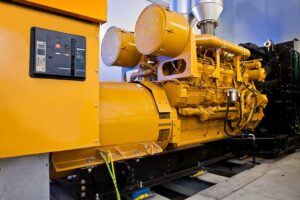
If you’re in the market for a commercial generator, one of the first steps is to figure out what size you need. Generators offer a huge range of power supply capacities, anywhere from just a few kilowatts to several megawatts. Different buildings have different power needs, so there is no one-size-fits-all solution. Fortunately, there are a few ways to estimate the size of generator you need. This can help as you browse our inventory and consider which units might work for you. Let’s talk about generator sizing, why it’s important, and how to get an approximate kilowatt capacity for your needs.
Ready to Buy a Commercial Generator? Make Sure You Get the Right Size!
Sizing for generators is extremely important for your building. As you browse our large inventory of new and used generators, you may have noticed that the kilowatts for each unit is listed pretty prominently. Of course, if you’ve bought a generator before, then you know why this is. However, if you’re new to the process, kilowatt rating is one of the most important factors of determining which generator is right for your needs. This is essentially the capacity of power that the generator can provide. Knowing how much power you need helps you find a practical generator for your building.
Undersizing and oversizing generators is a common but serious problem that can have negative effects on your business. Undersized generators can’t generate enough power for the demand. With undersized generators, you might have unreliable power and the generator may run too hard to try to keep up, leading to higher maintenance and operation costs. Undersizing can also damage your electrical system or equipment.
Of course, oversizing has its drawbacks as well. If you get a generator with way more capacity than you will ever need, then you can run into inefficient and expensive generator operation. Also, this can lead to damage for the generator (including wet stacking) and for your electrical system and equipment. Therefore, it’s best to accurately calculate size for your generators.
How Much Power Do You Need from a Commercial Generator?
Sizing a commercial generator means you need to sit down and think about exactly what you want it to do. Knowing what kinds of equipment you will need the generator to run can help you as you consider generator sizes and calculating your backup power requirements. You might choose to have a generator that only supplies power for critical safety systems or you might want a generator that has higher capacities for running non-essential equipment.
Critical Power Generator Only for Emergency/Safety Systems
One of the first options is using your set as a critical power generator. This essentially means that when the power goes out, you only want to run necessary equipment from the generator. For instance, emergency lighting systems, alarms, elevators, and other equipment needed for keeping people safe and assisting with any necessary evacuations. This method is usually a minimum requirement for commercial buildings according to life safety and fire codes. For this type of generator, you simply need to add up the kilowatts necessary to run these essential systems and choose a generator that matches those needs (plus a little extra in reserve capacity, just in case).
Commercial Generators for Business Continuity During Outages
Every minute of non-productive time due to power outages can cost significant amounts in lost revenue and low productivity. Therefore, many businesses choose generators that power everything they need for business continuity. For instance, in offices this might be lights, computers, copy machines, and other equipment. Basically, the purpose of the generator in this situation is to provide complete backup power so you things are business as usual even during power outages. This is becoming an even more popular option for commercial buildings when it comes to power generation.
Calculating Size Requirements for a Commercial Generator
For the purposes of this article, we are going to show you a few ways to calculate power requirements for generators you will use for complete business continuity. This is the most popular option and can be a little more complex than just emergency power generators for commercial buildings.
There are many different methods to calculate how much power capacity you actually need from a generator. Of course, these are no substitute for having a qualified electrician calculate your power requirements and find the right capacity for your generator. However, they can help give you a ballpark estimate as you begin researching and budgeting to buy a commercial generator for your building.
Full Load Capacity Method
The first option for figuring out the right kilowatt size for your generator is to do a full load capacity measurement. This method involves measuring power use during peak hours. Simply use an ammeter to measure usage at the service panel. From there, you can convert the amps into kilowatts so you can find the right generator size. To do so, you can use an amp to kilowatt conversion calculator.
You can also use a formula to help find the right kilowatt size for a generator:
Take the total number of amps and divide by three (because most commercial buildings need a three phase generator), multiply by the supply voltage, then multiply by 1,000. This will give you the number of kilowatts you would need for your generator.
Keep in mind that in most cases when you’re performing a full capacity measurement, you likely won’t have power running to emergency or safety systems, so be sure to add the necessary kilowatt usage for those systems as well.
Power Use History Method
Another way to determine the size of generator you need is to look at your electricity usage history. In most cases, usage will be found on your building’s electricity bill. Gather bills from at least the last 12 months. From there you can find the highest peak in power usage. Generally, all you need to do is take that usage number and add 25% for reserve capacity to determine approximate size for your generator.
Kilowatts Per Square Foot Method
Also, you can estimate generator size based on the square footage of your building. To do this, you take an estimate of the average amount of power most commercial buildings use per square foot of space. Then, you take that average and multiply it by how many square feet of space your building has.
For most commercial applications, this measurement is 50 kilowatts plus 5 watts for every square foot. However, retail establishments typically need 50 kilowatts plus 10 watts for every square foot.
With this method, keep in mind that it is a complete estimation. Different commercial buildings have different power needs, so this may not work for every situation.
Generator Country – Reliable Power Solutions
When you need a generator, our team at Generator Country is here to help. We are your number one source for generators. We offer new and used generator units to suit your requirements. Our used units are expertly serviced and refurbished to provide you with reliable power generation and quicker delivery timelines. Contact us now to buy a generator for your industrial or commercial building.
We also buy used generators! If you have a pre-owned unit that you no longer need or use, sell us your generator. Our team can provide you with competitive offers and also work out the logistics of removing it from your facility. You just tell us about the unit and we’ll take it from there and provide immediate payment for used generators. Reach out to sell your used generator to us.

